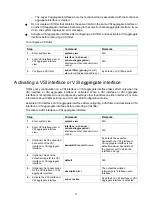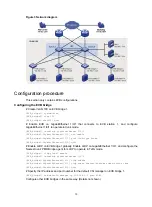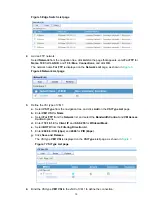
10
Step Command
Remarks
an S-channel.
Configuring a VSI filter
The EVB bridge uses a VSI filter to identify VSI traffic for a VM. Typically a VSI manager assigns
filters to VMs. Perform this task to manually create or remove a VSI filter.
A VSI filter contains a set of VID values, MAC addresses, and group ID values. EVB supports the
following filter info formats:
•
VLAN ID.
•
VLAN ID + MAC.
•
Group ID + VLAN ID.
•
Group ID + VLAN ID + MAC.
When you configure a VSI filter on a VSI interface, follow these restrictions and guidelines:
•
For the VSI filter configuration to take effect, make sure the S-channel interface to which the
VSI interface belongs operates in trunk mode.
•
When you create a VSI filter, the following interfaces automatically permit the VLAN contained
in the VSI filter:
{
The S-channel interface to which the VSI interface belongs.
{
The Layer 2 Ethernet interface where the S-channel that is associated with the S-channel
interface is created.
•
When you delete a VSI filter, the following interfaces automatically deny the VLAN in the filter if
the VSI filters on the other VSI interfaces created on the same S-channel interface do not
contain the VLAN:
{
The S-channel interface to which the VSI interface belongs.
{
The Layer 2 Ethernet interface where the S-channel that is associated with the S-channel
interface is created.
•
Do not create a VSI filter that contains the same VLAN on the same VSI interface or on other
VSI interfaces that belong to the same S-channel interface. If you do so, the system displays an
error message.
•
Disabling MAC address learning for an S-channel prevents the traffic from the VSI from being
forwarded if the VSI filter contains the VLAN to which the traffic belongs.
•
Activate a VSI interface after configuring a VSI filter, and deactivate a VSI interface before
removing a VSI filter.
When you configure a VSI filter on a VSI aggregate interface, follow these restrictions and
guidelines:
•
For the VSI filter configuration to take effect, make sure the S-channel aggregate interface to
which the VSI aggregate interface belongs operates in trunk mode.
•
When you create a VSI filter, the following interfaces automatically permit the VLAN contained
in the VSI filter:
{
The S-channel aggregate interface to which the VSI aggregate interface belongs.
{
The Layer 2 aggregate interface where the S-channel that is associated with the S-channel
aggregate interface is created.
•
When you delete a VSI filter, the following interfaces automatically deny the VLAN in the filter if
the VSI filters on the other VSI aggregate interfaces created on the same S-channel aggregate
interface do not contain the VLAN:
{
The S-channel aggregate interface to which the VSI aggregate interface belongs.










































